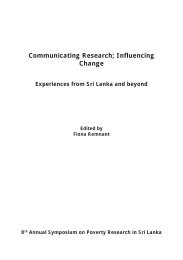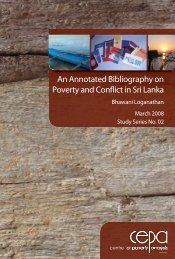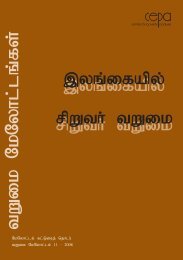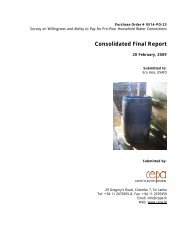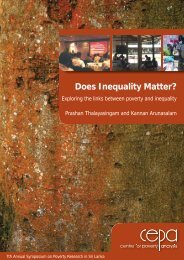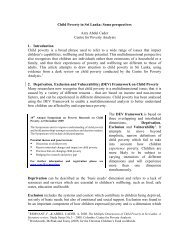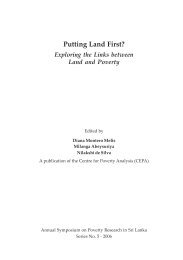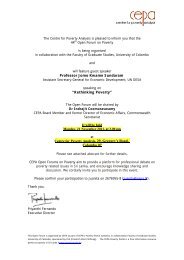Involuntary Displacement and Resettlement â Policy and ... - CEPA
Involuntary Displacement and Resettlement â Policy and ... - CEPA
Involuntary Displacement and Resettlement â Policy and ... - CEPA
- No tags were found...
Create successful ePaper yourself
Turn your PDF publications into a flip-book with our unique Google optimized e-Paper software.
1.2 Protracted <strong>Displacement</strong> <strong>and</strong> VulnerabilityThe categorisation of people as IDPs associates them with a certain type ofvulnerability, <strong>and</strong> requires that the state <strong>and</strong> development institutions dealwith them in a certain way, based on norms <strong>and</strong> practices developed chieflyby UN agencies (See Brun, in this volume for a more detailed description ofthe construction of the IDP categorisation <strong>and</strong> its associated vulnerability).This vulnerability is closely tied to their sense of impermanence in theirplaces of exile. Their ‘temporariness’ shapes the responses of development<strong>and</strong> state actors <strong>and</strong>, as in the case in Puttalam, also colours the response ofthe host community.Most IDPs in Puttalam have been there since their expulsion in 1990. Theirlong stay in the district, <strong>and</strong> their maintenance of the IDP label, challengethe traditional notions of vulnerability associated with this category. Theirlong period of settlement has brought a considerable amount of changeamong the IDP communities. Many of them exhibit signs of settlingpermanently in the Puttalam district: buying l<strong>and</strong> <strong>and</strong> establishingpermanent houses <strong>and</strong> businesses in the district.According to the 2006 UNHCR survey, the majority of Puttalam IDPs havealready de facto integrated into Puttalam. 74% of the IDPs surveyed claimto have acquired l<strong>and</strong> in Puttalam; 58% reported that they also possess ahouse. Some groups allege that the respondents misreported this in order tomake themselves eligible for housing grants that were being provided by alarge multilateral donor funded project in the district. Despite these claimsthe indication that IDPs would rather settle in Puttalam remains.During the period of ceasefire between 2002 <strong>and</strong> 2006, many IDPs sentmembers of their families back to their places of origin to explore thepossibility of return. The desire to return faded with the collapse of theceasefire. Aside from this brief window in which return was considered,many IDPs made strong social links <strong>and</strong> purchased fixed assets that seem toindicate a willingness to settle permanently in Puttalam.Further evidence of the integration of the IDPs <strong>and</strong> hosts is a cross influenceof cultural practices. Some cultural practices of IDPs, such as dowry <strong>and</strong> theirmanner of dress, have begun to influence the host community. The dowrysystem, for example, was not widely prevalent among Puttalam Muslimsbefore the arrival of IDPs, but is becoming a more common practice.114



